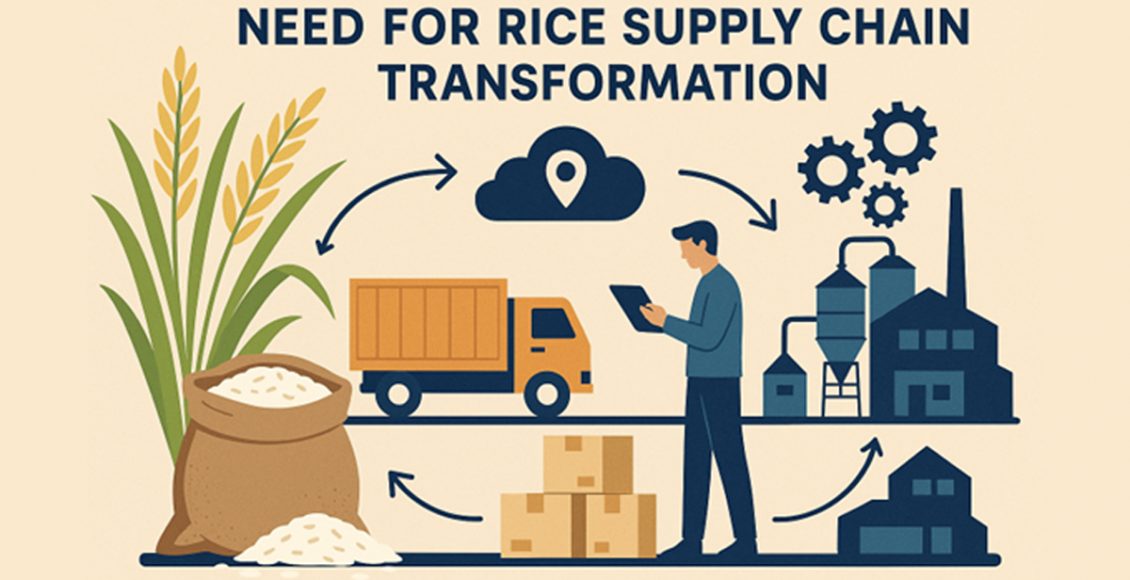
India’s Rice Exports and Virtual Water Trade: Need for Rice Supply Chain Transformation
Introduction
India is home to 18% of the global population but has only 4% of freshwater resources (National Water Mission, GoI). With dwindling water resources, India is categorized as ‘water insecure’ (Global Water Security 2023 Assessment) and an ‘extremely high-water stress’ country (WRI Aqueduct Water Risk Atlas). As per 2022 assessment, India’s annual extractable groundwater resource was 398 billion cubic meters (BCM), with annual groundwater extraction for all uses being 239 BCM, out of which 208 BCM (87%) was for agriculture (Ministry of Jal Shakti, GoI). Increasing population is driving more water demand for drinking, industrial manufacturing & increased food production. The climate change impact through extreme weather events like drought, high temperatures, erratic rainfall, etc, will further deepen the stress on the country’s water resources and availability. In this context, virtual water trade is gaining attention for the sustainable management of water resources. In recent years, India has become a major exporter of virtual water, exporting water embedded in agricultural commodities.
Virtual Water Trade and Its Impact
The ‘Virtual Water’ is the hidden or embedded water used in the production of agricultural and industrial goods. The Virtual Water Trade (VWT) is the amount of water consumed in the production of agricultural goods and then traded in international markets. A net virtual water export can impact a country’s water security and food sustainability. Hence, assessment of water footprint & virtual water trade is critical for natural resource management and ensuring water and food sustainability.
Indian Rice Exports and Contribution to VWT: Rice cultivation is highly water-intensive, requiring an average of 2500 litres (or 2.5 m3) of water to produce 1 kg of rice (or 2500 m3 per ton). India, accounting for over 40% of global rice exports, is the largest exporter of virtual water. Table 1 provides the estimated VWT contribution of rice exports (calculated based on an average of 2.5 m3 of water / 1 kg of rice).
Table 1. The contribution of rice exports to virtual water trade (VWT)
| Rice type exported | 2021-22 | 2022-23 | 2023-24 |
| Basmati (million MT) | 3.94 | 4.56 | 5.24 |
| Non-Basmati (million MT) | 17.29 | 17.79 | 11.11* |
| Total (million MT) | 21.23 | 22.35 | 16.35 |
| VWT (billion m3/ BCM) | 53.07 | 55.87 | 40.87 |
*Exports significantly declined in 2023-24 due to the export ban on non-basmati rice
India’s top ranking in rice exports comes at the cost of increasing water stress and water insecurity. The estimated VWT of 40.87 BCM in 2023-24 can meet nearly 17% of India’s annual groundwater extraction for all uses and 19.6% for agricultural use. This highlights the risks VWT from rice exports imposes on long-term agricultural sustainability and water security in India, especially in water-stressed regions like Punjab, Haryana, and western UP. This situation, coupled with the climate change impact is leading to higher risks/vulnerabilities in the rice supply chain.
Vulnerabilities in the Rice Supply Chain
The Indian rice supply chain actors face several risks/vulnerabilities, including:
Lowered rice productivity: Climate change and water stress in rice-producing areas can significantly impact rice productivity, especially in areas with groundwater depletion.
Overdependence in select regions: Most of India’s rice exports originate from Punjab, Haryana, and Western UP, which are classified as “overexploited” or “critical” in groundwater usage.
Policy and Regulatory Risks: Considering the growing global attention on sustainable management of water resources and the deepening climate change impact, the rice supply chain actors and the exporters in particular face potential policy and regulatory risks such as:
- Limit or ban on rice exports by the government, non-basmati rice in particular, during droughts or production shortfalls.
- Enforcement of groundwater regulations on capping water extraction, restricting borewell usage, etc., can limit rice production in water-stressed regions, affecting sourcing for traders/exporters.
- Crop diversification (substitution with maize or millets) and zoning mandates (restriction in high water stress areas or seasons) by state/ central governments to rationalize water resource utilization can lead to supply volume disruptions.
- The introduction of a virtual water tax on crops with high water footprints (like rice and sugarcane) to discourage their cultivation in water-deficient areas and promote exports with low water footprints. This tax introduction could reduce India’s rice competitiveness in global markets.
- Subsidy and MSP reforms: The phasing out of various subsidies and minimum support prices (MSPs) for water-intensive crops could increase production costs and reduce supplies for exports.
Market Risks: With increasing consumer awareness, international buyers/importers may impose sustainability or water stewardship certification requirements to support supply chain transparency, leading to higher compliance costs or non-compliant exporters losing market access.
Levers for Rice Supply Chain Transformation
Considering the implications of India’s virtual water trade and its risks on national water security, there is a growing need for transformation in rice production, procurement and trade. The critical elements or levers for rice supply chain transformation are discussed below:
Water – Smart Cultivation Practices: Government and Agribusinesses can promote water smart rice cultivation systems like Direct Seeded Rice (DSR), Alternate Wetting & Drying (AWD) practices in their procurement areas by providing trainings and incentives. DSR can help reduce water usage by up to 40% compared to the transplantation method.
De-risking/ Diversification of supply chains: Aggregators and exporters can shift their non-basmati procurement to states that are rain-fed and less water-stressed, reduce overdependence on a few export-oriented regions by creating processing and storage infrastructure in new sourcing zones.
Embedding Sustainable Procurement & Traceability: Aggregators and exporters can embed “water-smart sourcing” metrics into suppliers’ contracts, use digital tools for tracking water footprints in sourcing areas and adopt water stewardship programs.
Public-Private Partnerships: Industry can collaborate with central/state governments on crop diversification programs and leverage schemes like Pradhan Mantri Krishi Sinchayee Yojana (PMKSY) and Sahi Fasal (Ministry of Jal Shakti) to promote efficient irrigation and water management.
Incentivizing Water-Efficient Cultivation: Retailers & Buyers can support supply chain transparency, sourcing from certified sustainable rice suppliers, encourage premium pricing or preferential procurement and labelling for sustainably produced rice.
Conclusions:
Water sustainability and climate change impact have become major challenges in Indian rice production, leading to higher risks/vulnerabilities in the rice supply chain. Rice supply chain transformation driven by policy reforms, climate and water-smart practices is the need of the hour. Concerted and coordinated action is required by all stakeholders, including policy makers, producers, agribusinesses, exporters, retailers and buyers for making a paradigm shift in rice supply chain.
Author:

Connect with Author at: E-mail foodbiz@sathguru.com
 Grow Beyond
Grow Beyond 

